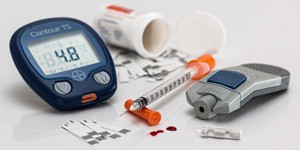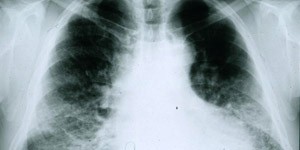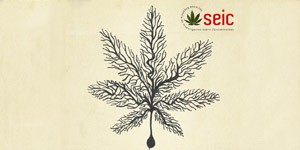By Viola Brugnatelli

Viola Brugnatelli is a neuroscientist and endocannabinologist, she carries out research and teaching on cannabis at the Dept. Of Neuroscience, University of Padua, Italy, and is the co-founder of
Cannabiscienza, an education company for healthcare professionals on the endocannabinoid system and medical cannabis.
A long standing member of the International Cannabinoid Research Society, and Italian Ambassador for the International Association for Cannabis Medicine, Viola's background is in pharmacology labs, specialising in orphan cannabinoid/terpenoid receptors and their signalling in pain and inflammation.
Currently she collaborates with Fundación Canna, the Journal of Cannabinoid Medicine editorial board, and as a guest author for a series of magazines in the field, including Project CBD. Viola
over the years contributed to several CME courses on cannabis, educating MDs and pharmacists worldwide. She is the VP of a non-for-profit that aims to empower women working with plant medicine.
What fascinates her most about the cannabis plant is what we can learn and understand about the endocannabinoid system and how to modulate it in different ways beyond phytocannabinoids. Lately she has been closely working with anaesthesiologists who operate with hypnotherapy to
evaluate the role of the ECS in the ability of altering our states of consciousness without drugs.
1. Brazilian research: international award to more than 40 years of CBD discoveries
During the latest International Association for Cannabinoid Medicine (IACM) symposium, a 3-day event which is held biennially in Europe, Professor Crippa, University of Sao Paolo, was awarded for the significant contribution of his work and that of his group in the understanding of the role of cannabidiol, (CBD), a non-psychoactive component of Cannabis sativa, in neuropsychiatry.
The history of Brazilian scientists in this field traces back to the 1970s, when the potential therapeutic effects of CBD were demonstrated both in different animal models of neuropsychiatric disorders, as well as in clinical trials with humans, making them the first researchers to highlight the anxiolytic and antipsychotic effects of CBD. (1)
In 1982 they were able to test the interaction between CBD and Δ9-THC in healthy volunteers, finding that high oral doses of Δ9-THC provoked anxiety and psychotic symptoms, which were attenuated when CBD was administered together with Δ9-THC. (2)
These promising experiments led to a series of further investigations that established, from cell and animal studies to patients, a clear link between CBD and antipsychotic activity.
2. How does CBD work?
Clearly, one of the main questions of the scientists working on this field worldwide is: what is the mechanism of function by which CBD induces anxyolitic, antipsychotic and antidepressant effects?
2.1 Modulation of the emotional response to fear
Using functional magnetic resonance imaging (fMRI) scientists have been able to show the neural correlates of the anxiolytic effects of 600 mg CBD in 15 healthy subjects which were exposed to intensely fearful faces. (3) Cannabidiol attenuated the responses in the anterior and posterior cingulate and amygdala (brain areas that modulate our emotions) and controlled the skin conductance responses to fearful stimuli.
These data were confirmed by a subsequent study in which the anxiolytic effects of CBD corresponded with an alteration in the prefrontal-subcortical connectivity via amygdala and the anterior cingulate. (4)
It is interesting to note that CBD attenuated the level of blood oxygenation in the amygdalae of healthy subjects exposed to different levels of anxiety.
This seems not only relevant to generalised anxiety, but may offer a rationale for psychiatric management following traumatic events; indeed, the amygdala is hyperactive in patients with PTSD and may be correlated to the severity of the symptoms. (5)
2.2 Modulation of FAAH: CBD anxiolytic / antidepressant / pro-social effects
CBD has a weak interaction with classic cannabinoid receptors CB1 and CB2. (6) Some of the leading pioneers of this field suggested almost 20 years ago that CBD may inhibit the breakdown of the endocannabinoid Anandamide (AEA). (7) Fatty Acid Amide Hydrolase (FAAH) is an enzyme that hydrolyses AEA; CBD prevents this enzyme from functioning and therefore increases the endocannabinoid signal.
It has been noted that some pathologies share a deficiency in endocannabinoid tone (31) and that eCB deficiency seems predisposing the individual to the development of trauma-related psychopathology. (8)
The topic remains open, as more research is needed to clarify some conflicting evidence on the role of CBD and FAAH(9); however, during the IACM 2019, another luminary scientist presented his research, Dr Daniele Piomelli, from the University of California Irvine School of Medicine, on the pharmacology of FAAH inhibition and its implication in increased healing, mood elevation and decreased pain perception. (10, 11, 12)
Professor Piomelli also reported the real-life story of a Scottish lady who was found with a genetic mutation at FAAH. The 66-year old lady had a particularly good mood and total absence of pain detection, despite painful orthopaedic hand surgery and the gloomy Scottish weather. This is not just a headline story for The Sun, the woman, despite frequent cuts and burns, was observed to heal quickly. She was found with higher blood levels in endocannabinoids AEA, OEA, and PEA, confirming the role of FAAH enzyme inhibition in several of the effects that are also observed with CBD treatment, such as an enhancement of the endocannabinoid tone. (9, 13
2.3 CBD: serotoninergic interaction and neurogenesis
The antidepressant and pro-social effects of CBD may be found in its ability to activate the serotoninergic receptors 5-HT1A. (14, 15)
Another interesting route by which CBD may exert its role in processing memories and considered an important feature to rescue aversive memories in patients with PTSD, is by facilitating neurogenesis (creation of new brain connections) in the hippocampus, a well known brain area for learning and memory. (16, 17)
3. CBD for schizophrenia: clinical evidences
The first clinical trials, dating back to 1995, were open-labeled and with a small number of patients due ethical reasons. A 19-year old female with schizophrenia refractory to other anti-psychotic drugs and enduring difficult side effects, was treated for four weeks with increasing doses of CBD up to 1,500 mg/day. CBD treatment significantly reduced the scores of the Brief Psychiatric Rating Scales (BPRS). (18)
The first double-blind controlled clinical trial of CBD compared its effects during four-weeks with those of amisulpride, an antipsychotic drug, on 42 schizophrenic individuals.
The scores of BPRS and Positive and Negative Syndrome Scale (PANSS) decreased significantly under both treatments with no differences between them. However, the side effects typically observed with amisulpride (extra pyramidal symptoms, increase in prolactin levels and weight gain) were not significant with CBD. (19)
Another clinical trial was conducted comparing treatment with CBD or placebo for 28 days in first-episode schizophrenic patients. There were ten drop-out patients in the placebo and one in the CBD treatment groups. The CBD group benefited with a significant reduction in psychotic symptoms when compared with baseline. (20)
More recently, in a double-blind trial, 88 patients with schizophrenia were randomized to receive for 6 weeks CBD (1,000 mg/day) or placebo added-on to their existing antipsychotic medications. After the treatment, the CBD group presented lower positive psychotic scores and improved cognitive and general illness symptoms. CBD and placebo side-effects were equivalents between groups. (21)
Taken together, these studies strongly suggest that CBD induces therapeutic effect in psychotic symptoms. However, as aforementioned, its mechanisms of action are still unclear.
4. CBD for anxiety: clinical evidences
In 1993 the anxiolytic effect of CBD was first tested in a double-blind, placebo-controlled procedure in healthy volunteers administered with a test which simulates public speaking stress (named Simulated Public Speaking Test or for short SPST).
As the subjects are undergoing the SPST, they are asked to determine their subjective state of anxiety whilst physiological measures (such as heart rate, blood pressure, skin conductance) are recorded.
The anxiolytic effects of CBD at a 300 mg dosage were compared with those produced by two anxiolytic compounds, ipsapirone (5 mg) and diazepam (10 mg); all three compounds attenuated anxiety induced by the SPST. (22)
More recently, the research group confirmed and expanded this finding with subjects who were assigned to five groups that received CBD (100, 300, and 900 mg), the benzodiazepine clonazepam (1 mg) and placebo and underwent a test of public speaking in a real situation (TPSRS) where each volunteer had to speak in front of a group composed by the other participants resulting in decrease in anxiety only with the CBD 300 mg dose, but not with the other CBD doses of 100 and 900 mg. (23)
As another author noted, such bell-shape dose-effect of CBD isolate may be rescued by the whole-plant compounds present utilising CBD enriched with the whole-plant extract. (24)
A group of patients with social anxiety disorder (SAD) were treated with CBD and compared their anxiety levels with SAD patients who received placebo.
The CBD group had lower anxiety levels, a reduction in subjective measures of anxiety, and fewer somatic symptoms compared with placebo. (25) On top of that, SAD patients treated with CBD did not experience sedation and were found no different than healthy controls, unlike what happened with SAD patients taking placebo. (26)
5 CBD for PTSD = useful but not decisive evidence
In 2013 a study showed that inhaled CBD (at a dose of 32 mg) caused a reduction in the skin conductance response to fear, as well as in the expectation levels for the exposure to an aversive stimuli. (27)
In 2016 a case-study illustrated the use of CBD in paediatric psychiatry. A 10-year-old child who developed PTSD after being sexually abused before the age of five underwent standard pharmacological treatment for the condition, which produced short-lasting partial relief, as well as significant side effects.
The child was administered a dose of 12–25 mg once a day of CBD oil and showed significant relief of the symptomatology, such as anxiety and sleep disturbance, while inducing minimal side effects. (28)
6. CBD for Parkinson's Disease
CBD has been tested in an open trial examining six out-patients with Parkinson ́s disease (PD) treated with dopaminergic drugs (L-Dopa 300 mg) that presented psychotic symptoms. They were administered a flexible oral dose of CBD (150 to 400mg/day) for four weeks, in addition to their usual treatment. The scores of BPRS and Parkinson Psychosis Questionnaire were significantly decreased under CBD treatment. No worsening of motor function or other adverse effects was observed during CBD treatment. (29)
Following this first study, the group continued with 21 PD patients which were examined at baseline and after treatment in regard to motor and general symptoms, quality of life and well-being, and neuroprotective effects. The group treated with CBD 300 mg/day presented significantly better scores in quality of life, and a general improvement in parkinsonism. (30)
Conclusions
Professor Crippa summarised in depth the multifarious effects of CBD in neuropsychiatry which him and his group have been studying with much intensity.
Although further clinical evidence is still needed, and many questions remain open, the data on the use of this molecule in neuropsychiatry looks very promising. May more scientists walk the path that Crippa and colleagues have brought out and continue shedding light on the use of Cannabidiol as an anti-psychothic, anxiolytic and or antidepressant.
Referencess
1. Zuardi AW. Cannabidiol: from an inactive cannabinoid to a drug with wide spectrum of action. Rev Bras Psiquiatr. (2008) 30:271–80.
2. Zuardi AW, Shirakawa I, Finkelfarb E, Karniol IG. Action of can- nabidiol on the anxiety and other effects produced by delta 9-THC in normal subjects. Psychopharmacology (Berl) 1982; 76: 245-50.
3. Fusar-Poli P, Crippa JA, Bhattacharyya S, Borgwardt SJ, Allen P, Martin-Santos R, et al. Distinct effects of {delta}9-tetrahydrocannabinol and cannabidiol on neural activation during emotional processing. Arch Gen Psychiatry (2009) 66:95–105.
4. Fusar-Poli P, Allen P, Bhattacharyya S, Crippa JA, Mechelli A, Borgwardt S, et al. Modulation of effective connectivity during emotional processing by Delta9-tetrahydrocannabinol and cannabidiol. Int J Neuropsychopharmacol. (2009) 13:421–32.
5. Shin, Lisa M., Scott L. Rauch, and Roger K. Pitman. "Amygdala, medial prefrontal cortex, and hippocampal function in PTSD." Annals of the New York Academy of Sciences 1071.1 (2006): 67-79.
6. Pertwee, R. G. (2008). The diverse CB1 and CB2 receptor pharmacology of three plant cannabinoids: Δ9‐tetrahydrocannabinol, cannabidiol and Δ9‐tetrahydrocannabivarin. British journal of pharmacology, 153(2), 199-215
7. Bisogno T, Hanus L, De Petrocellis L, Tchilibon S, Ponde DE, Brandi I, Moriello AS, Davis JB, Mechoulam R, Di Marzo V (2001) Molecular targets for cannabidiol and its synthetic analogues: effect on vanilloid VR1 receptors and on the cellular uptake and enzymatic hydrolysis of anandamide. Br J Pharmacol. Oct; 134(4):845-52
8. Hill, M. N., Campolongo, P., Yehuda, R., and Patel, S. (2018). Integrating endocannabinoid signaling and cannabinoids into the biology and treatment of posttraumatic stress disorder. Neuropsychopharmacology 43, 80–102.
9. Bitencourt RM and Takahashi RN (2018) Cannabidiol as a Therapeutic Alternative for Post-traumatic Stress Disorder: From Bench Research to Confirmation in Human Trials. Front. Neurosci. 12:502.
10. Danandeh, Andalib, Valentina Vozella, James Lim, Fariba Oveisi, Gina L. Ramirez, David Mears, Gary Wynn, and Daniele Piomelli. "Effects of fatty acid amide hydrolase inhibitor URB597 in a rat model of trauma-induced long-term anxiety." Psychopharmacology 235, no. 11 (2018): 3211-3221.
11. Russo, R., LoVerme, J., La Rana, G., Compton, T.R., Parrott, J., Duranti, A., Tontini, A., Mor, M., Tarzia, G., Calignano, A. and Piomelli, D., 2007. The fatty acid amide hydrolase inhibitor URB597 (cyclohexylcarbamic acid 3′-carbamoylbiphenyl-3-yl ester) reduces neuropathic pain after oral administration in mice. Journal of Pharmacology and Experimental Therapeutics, 322(1), pp.236-242.
12. Bortolato, Marco, Regina A. Mangieri, Jin Fu, Janet H. Kim, Oliver Arguello, Andrea Duranti, Andrea Tontini, Marco Mor, Giorgio Tarzia, and Daniele Piomelli. "Antidepressant-like activity of the fatty acid amide hydrolase inhibitor URB597 in a rat model of chronic mild stress." Biological psychiatry 62, no. 10 (2007): 1103-1110.
13. Habib AM, Okorokov AL, Hill MN, Bras JT, Lee MC, Li S, Gossage SJ, van Drimmelen M, Morena M, Houlden H, Ramirez JD. Microdeletion in a FAAH pseudogene identified in a patient with high anandamide concentrations and pain insensitivity. British journal of anaesthesia. 2019 Mar 28.
14. Russo, E. B., Burnett, A., Hall, B., and Parker, K. K. (2005). Agonistic properties of cannabidiol at 5-HT1a receptors. Neurochem. Res. 30, 1037–1043.
15. Rock, E. M., Bolognini, D., Limebeer, C. L., Cascio, M. G., Anavi-Goffer, S., Fletcher, P. J., et al. (2012). Cannabidiol, a non-psychotropic component of cannabis, attenuates vomiting and nausea-like behaviour via indirect agonism of 5-HT(1A) somatodendritic autoreceptors in the dorsal raphe nucleus. Br. J. Pharmacol. 165, 2620–2634.
16. Campos, A. C., Ortega, Z., Palazuelos, J., Fogaça, M. V., Aguiar, D. C., Díaz-Alonso, J., ... & Galve-Roperh, I. (2013). The anxiolytic effect of cannabidiol on chronically stressed mice depends on hippocampal neurogenesis: involvement of the endocannabinoid system. International Journal of Neuropsychopharmacology, 16(6), 1407-1419.
17. Wolf, S. A., Bick-Sander, A., Fabel, K., Leal-Galicia, P., Tauber, S., Ramirez-Rodriguez, G., et al. (2010). Cannabinoid receptor CB1 mediates baseline and activity-induced survival of new neurons in adult hippocampal neurogenesis. Cell Commun. Signal. 8:12.
18. Zuardi AW, Morais SL, Guimarães FS, Mechoulam R. Anti-psychotic effect of cannabidiol. J Clin Psychiatry 1995; 56(10): 485-6.
19. Leweke FM, Piomelli FM, Pahlisch F, Muhl D, Gerth CW, Hoyer C, Klosterkötter J, Hellmich M, Koethe D. Cannabidiol enhances anandamide signaling and alleviates psychotic symptoms of schizophrenia. Translational Psychiatry 2012, e94; doi:10.1038/tp.2012.15.
20. Leweke FMM, Kranaster L, Pahlisch F, et al. The efficacy of cannabidiol in the treatment of schizophrenia - a translational approach. Schizophr Bull 2011; 37 (Supp 1): 313.
21. McGuire P, Robson P, Cubala WJ, Vasile D, Morrison PD, Barron R, et al. Cannabidiol (CBD) as an adjunctive therapy in schizophrenia: a multicenter randomized controlled trial. Am J Psychiatry (2018) 175:225–31. doi: 10.1176/appi.ajp.2017.17030325
22. Zuardi, Antonio & Cosme, RA & Graeff, Frederico & Guimarães, Francisco. (1993). Effects of ipsapirone and cannabidiol on human experimental anxiety. Journal of psychopharmacology (Oxford, England). 7. 82-8. 10.1177/026988119300700112.
23. Zuardi AW, Rodrigues NP, Silva AL, Bernardo SA, Hallak JEC, Guimarães FS, et al. Inverted U-shaped dose-response curve of the anxiolytic effect of cannabidiol during public speaking in real life. Front Pharmacol. (2017) 8:259. doi: 10.3389/fphar.2017.00259
24. Gallily, Ruth, Zhannah Yekhtin, and Lumír Ondřej Hanuš. "Overcoming the bell-shaped dose-response of cannabidiol by using cannabis extract enriched in cannabidiol." Pharmacology & Pharmacy 6, no. 02 (2015): 75.
25. Bergamaschi MM, Queiroz RH, Chagas MH, de Oliveira DC, De Martinis BS, Kapczinski F, et al. Cannabidiol reduces the anxiety induced by simulated public speaking in treatment-naïve social phobia patients. Neuropsychopharmacology (2011) 36:1219–26. doi: 10.1038/npp.2011.6
26. Crippa JA, Zuardi AW, Garrido GE, Wichert-Ana L, Guarnieri R, Ferrari L, et al. Effects of cannabidiol (CBD) on regional cerebral blood flow. Neuropsychopharmacology (2004) 29:417–26. doi: 10.1038/sj.npp.1300340
27. Das, R. K., Kamboj, S. K., Ramadas, M., Curran, H. V., and Morgan, C. J. A. (2013). Cannabidiol enhances consolidation of explicit fear extinction in humans. Psychopharmacology 2, 781–792. doi: 10.1007/s00213-012-2955-y
28. Shannon, S., and Opila-Lehman, J. (2016). Effectiveness of cannabidiol oil for pediatric anxiety and insomnia as part of posttraumatic stress disorder: a case report. Perm. J. 20, 108–111. doi: 10.7812/TPP/16-005
29. Zuardi AW, Crippa JA, Hallak JE, et al. Cannabidiol for the treatment of psychosis in Parkinson's disease. J Psychopharmacol 2009; 215. 23: 979-83.
30. Chagas MH, Eckeli AL, Zuardi AW, Pena-Pereira MA, Sobreira-Neto MA, Sobreira ET, et al. Cannabidiol can improve complex sleep-related behaviors associated with rapid eye movement sleep behavior disorder in Parkinson's disease patients: a case series. J Clin Pharm Ther. (2014) 39:564–6. doi: 10.1111/jcpt.12179
31. Russo, E. B. (2016). Clinical endocannabinoid deficiency reconsidered: current research supports the theory in migraine, fibromyalgia, irritable bowel, and other treatment-resistant syndromes. Cannabis and cannabinoid research, 1(1), 154-165.


